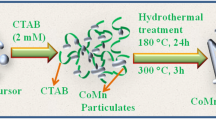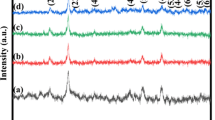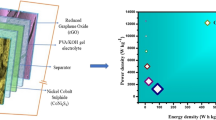Abstract
Mixed transition metal oxides/spinels are excellent energy storage electrode materials that can deliver sizeable specific capacitance, excellent cyclic stability, and good rate capability than their single metal oxide analogues. Synthetic methods and strategies greatly influence materials’ structure, morphology, and functionality. Among several strategies employed to improve the capacitance of metal oxides, the addition of surfactant is one of the simple strategies that help profoundly increase the electrode material’s surface area/active sites. This study prepared a tetragonal spinel CoMn2O4 material using a simple hydrothermal approach by a surfactant, polyvinylpyrrolidone (PVP)-based morphological strategy. Electrochemical techniques such as cyclic voltammetry (CV) and galvanostatic charge/discharge cycling (GCD) were used to investigate the active material’s energy storage properties. The structural and morphological properties were studied using XRD, SEM, and TEM techniques. The obtained CoMn2O4 material has unique and beautiful Indian borage shrub-like morphology. The unique morphology of CoMn2O4 material provided excellent electrochemical properties by virtue of its enhanced physicochemical properties like pore size distribution, increased surface area, and many active sites for electrolyte ions that incurred large specific and areal capacitances. Further, the significant structural integrity provides extended cycling stability (~116% capacity retention) with high Coulombic efficiency of ~98% even after 6000 cycles without any dwindle in capacitance value. These fascinating features make CoMn2O4 a promising and optimistic pseudocapacitive electrode material.
Graphical Abstract










Similar content being viewed by others
References
Simon P, Gogotsi Y, Dunn B (2014) Where do batteries end and supercapacitors begin? Science 80(343):1210–1211. https://doi.org/10.1126/science.1249625
González A, Goikolea E, Barrena JA, Mysyk R (2016) Review on supercapacitors: technologies and materials. Renew Sust Energ Rev 58:1189–1206. https://doi.org/10.1016/j.rser.2015.12.249
Raza W, Ali F, Raza N et al (2018) Recent advancements in supercapacitor technology. Nano Energy 52:441–473. https://doi.org/10.1016/j.nanoen.2018.08.013
Fleischmann S, Mitchell JB, Wang R et al (2020) Pseudocapacitance: from fundamental understanding to high power energy storage materials. Chem Rev 120:6738–6782. https://doi.org/10.1021/acs.chemrev.0c00170
Mathis TS, Kurra N, Wang X et al (2019) Energy storage data reporting in perspective—guidelines for interpreting the performance of electrochemical energy storage systems. Adv Energy Mater 9:1–13. https://doi.org/10.1002/aenm.201902007
Miller JR, Simon P (2008) Materials science: electrochemical capacitors for energy management. Science 321:651–652. https://doi.org/10.1126/science.1158736
Srivastav S, Paliwal MK, Meher SK (2022) Ribbon-like nickel cobaltite with layer-by-layer-assembled ordered nanocrystallites for next-generation all-solid-state hybrid supercapatteries. Langmuir 38:3969–3983. https://doi.org/10.1021/acs.langmuir.1c02844
Gogotsi Y, Penner RM (2018) Energy storage in nanomaterials - capacitive, pseudocapacitive, or battery-like? ACS Nano 12:2081–2083. https://doi.org/10.1021/acsnano.8b01914
Boujibar O, Ghamouss F, Ghosh A et al (2019) Activated carbon with exceptionally high surface area and tailored nanoporosity obtained from natural anthracite and its use in supercapacitors. J Power Sources 436:226882. https://doi.org/10.1016/j.jpowsour.2019.226882
Sahoo MK, Ranga Rao G (2021) A high energy flexible symmetric supercapacitor fabricated using N-doped activated carbon derived from palm flowers. Nanoscale Adv 3:5417–5429. https://doi.org/10.1039/d1na00261a
Meher SK, Justin P, Ranga Rao G (2010) Pine-cone morphology and pseudocapacitive behavior of nanoporous nickel oxide. Electrochim Acta 55:8388–8396. https://doi.org/10.1016/j.electacta.2010.07.042
Samal R, Mondal S, Gangan AS et al (2020) Comparative electrochemical energy storage performance of cobalt sulfide and cobalt oxide nanosheets: Experimental and theoretical insights from density functional theory simulations. Phys Chem Chem Phys 22:7903–7911. https://doi.org/10.1039/c9cp06434f
Meher SK, Ranga Rao G (2012) Enhanced activity of microwave synthesized hierarchical MnO2 for high performance supercapacitor applications. J Power Sources 215:317–328. https://doi.org/10.1016/j.jpowsour.2012.04.104
Wang L, Ji H, Wang S et al (2013) Preparation of Fe3O4 with high specific surface area and improved capacitance as a supercapacitor. Nanoscale 5:3793–3799. https://doi.org/10.1039/c3nr00256j
Umeshbabu E, Ranga Rao G (2016) Vanadium pentoxide nanochains for high-performance electrochemical supercapacitors. J Colloid Interface Sci 472:210–219. https://doi.org/10.1016/j.jcis.2016.03.050
Umeshbabu E, Rajeshkhanna G, Ranga Rao G (2014) Urchin and sheaf-like NiCo2O4 nanostructures: synthesis and electrochemical energy storage application. Int J Hydrogen Energy 39:15627–15638. https://doi.org/10.1016/j.ijhydene.2014.07.168
Rajeshkhanna G, Ranga Rao G (2018) High energy density symmetric capacitor using zinc cobaltate flowers grown in situ on Ni foam. Electrochim Acta 261:265–274. https://doi.org/10.1016/j.electacta.2017.12.115
Venkateswarlu P, Umeshbabu E, Naveen Kumar U et al (2017) Facile hydrothermal synthesis of urchin-like cobalt manganese spinel for high-performance supercapacitor applications. J Colloid Interface Sci 503:17–27. https://doi.org/10.1016/j.jcis.2017.05.007
Umeshbabu E, Justin P, Ranga Rao G (2018) Tuning the surface morphology and pseudocapacitance of MnO2 by a facile green method employing organic reducing sugars. ACS Appl Energy Mater 1:3654–3664. https://doi.org/10.1021/acsaem.8b00390
Li Y, Zhu G, Xu X et al (2022) Embedding metal–organic frameworks for the design of flexible hybrid supercapacitors by electrospinning: synthesis of highly graphitized carbon nanofibers containing metal oxide nanoparticles. Small Struct 3:2200015. https://doi.org/10.1002/sstr.202200015
Chen L, Xu X, Wan L et al (2021) Carbon-incorporated Fe3O4 nanoflakes: high-performance faradaic materials for hybrid capacitive deionization and supercapacitors. Mater Chem Front 5:3480–3488. https://doi.org/10.1039/d0qm00946f
Aparna ML, Thomas T, Ranga Rao G (2022) Battery-like supercapacitive behavior of urchin-shaped NiCo2O4 and comparison with NiCo2X4 (X = S, Se, Te). J Electrochem Soc 169:020515. https://doi.org/10.1149/1945-7111/ac4d6c
Aparna ML, Thomas T, Ranga Rao G (2022) Chimie douce derived nickelt cobalt oxynitride as electrode material for high energy density supercapacitors. J Electrochem Soc 418:140341. https://doi.org/10.1149/1945-7111/ac4d6c
Zhang C, Zheng B, Huang C et al (2019) Heterostructural three-dimensional reduced graphene oxide/CoMn2O4 nanosheets toward a wide-potential window for high-performance supercapacitors. ACS Appl Energy Mater 2:5219–5230. https://doi.org/10.1021/acsaem.9b00904
Ren L, Chen J, Wang X et al (2015) Facile synthesis of flower-like CoMn2O4 microspheres for electrochemical supercapacitors. RSC Adv 5:30963–30969. https://doi.org/10.1039/c5ra02663f
Syedvali P, Rajeshkhanna G, Umeshbabu E et al (2015) In situ fabrication of graphene decorated microstructured globe artichokes of partial molar nickel cobaltite anchored on a Ni foam as a high-performance supercapacitor electrode. RSC Adv 5:38407–38416. https://doi.org/10.1039/c5ra03463a
Luo Z, Shu D, Yi F et al (2021) Urchin-like NiCo2O4 hollow microspheres with oxygen vacancies synthesized by self-template for supercapacitor. New J Chem c: https://doi.org/10.1039/d1nj04153c
Umeshbabu E, Rajeshkhanna G, Ranga Rao G (2016) Effect of solvents on the morphology of NiCo2O4/graphene nanostructures for electrochemical pseudocapacitor application. J Solid State Electrochem 20:1837–1844. https://doi.org/10.1007/s10008-015-3022-5
Pattanayak B, Simanjuntak FM, Panda D et al (2019) Role of precursors mixing sequence on the properties of CoMn2O4 cathode materials and their application in pseudocapacitor. Sci Rep 9:16852. https://doi.org/10.1038/s41598-019-53364-2
Sandosh TA, Simi A (2021) Morphology controlled synthesis of one-dimensional CoMn2O4 nanorods for high-performance supercapacitor electrode application. Chem Pap 75:2295–2304. https://doi.org/10.1007/s11696-020-01448-z
Padmanathan N, Selladurai S (2014) Mesoporous MnCo2O4 spinel oxide nanostructure synthesized by solvothermal technique for supercapacitor. Ionics (Kiel) 20:479–487. https://doi.org/10.1007/s11581-013-1009-8
Wu C, Cai J, Zhang Q et al (2015) Direct growth of urchin-like ZnCo2O4 microspheres assembled from nanowires on nickel foam as high-performance electrodes for supercapacitors. Electrochim Acta 169:202–209. https://doi.org/10.1016/j.electacta.2015.04.079
Umeshbabu E, Rajeshkhanna G, Justin P, Ranga Rao G (2015) Magnetic, optical and electrocatalytic properties of urchin and sheaf-like NiCo2O4 nanostructures. Mater Chem Phys 165:235–244. https://doi.org/10.1016/j.matchemphys.2015.09.023
Vigneshwaran P, Kandiban M, Senthil Kumar N et al (2016) A study on the synthesis and characterization of CoMn2O4 electrode material for supercapacitor applications. J Mater Sci Mater Electron 27:4653–4658. https://doi.org/10.1007/s10854-016-4343-6
Jiang S, Shi T, Long H et al (2014) High-performance binder-free supercapacitor electrode by direct growth of cobalt-manganese composite oxide nansostructures on nickel foam. Nanoscale Res Lett 9:1–8. https://doi.org/10.1186/1556-276X-9-492
Yunyun F, Xu L, Wankun Z et al (2015) Spinel CoMn2O4 nanosheet arrays grown on nickel foam for high-performance supercapacitor electrode. Appl Surf Sci 357:2013–2021. https://doi.org/10.1016/j.apsusc.2015.09.176
Yuan C, Yang L, Hou L et al (2012) Growth of ultrathin mesoporous Co3O4 nanosheet arrays on Ni foam for high-performance electrochemical capacitors. Energy Environ Sci 5:7883–7887. https://doi.org/10.1039/c2ee21745g
Du H, Jiao L, Wang Q et al (2013) Facile carbonaceous microsphere templated synthesis of Co3O4 hollow spheres and their electrochemical performance in supercapacitors. Nano Res 6:87–98. https://doi.org/10.1007/s12274-012-0283-5
Rajeshkhanna G, Umeshbabu E, Justin P, Ranga Rao G (2015) In situ fabrication of porous festuca scoparia-like Ni0.3Co2.7O4 nanostructures on Ni-foam: An efficient electrode material for supercapacitor applications. Int J Hydrogen Energy 40:12303–12314. https://doi.org/10.1016/j.ijhydene.2015.06.046
Zhang L, He G, Lei S et al (2016) Hierarchical hollow microflowers constructed from mesoporous single crystalline CoMn2O4 nanosheets for high performance anode of lithium ion battery. J Power Sources 326:505–513. https://doi.org/10.1016/j.jpowsour.2016.07.021
Kutty RKN, Kasturi PR, Jaganath J et al (2019) Structural and magnetic properties of CoMn2O4 synthesized by auto combustion method. J Mater Sci Mater Electron 30:975–981. https://doi.org/10.1007/s10854-018-0366-5
Sim C, Majid SR, Zalina N (2019) Durable porous carbon/ZnMn2O4 composite electrode material for supercapacitor. J Alloys Compd 803:424–433. https://doi.org/10.1016/j.jallcom.2019.06.220
Saranya SPE (2018) Efficient electrochemical performance of ZnMn2O4 nanoparticles with rGO nanosheets for electrodes in supercapacitor applications. J Mater Sci Mater Electron 29:3326–3339. https://doi.org/10.1007/s10854-017-8268-5
Xu Y, Wang X, An C et al (2014) Facile synthesis route of porous MnCo2O4 and CoMn2O4 nanowires and their excellent electrochemical properties in supercapacitors. J Mater Chem A 2:16480–16488. https://doi.org/10.1039/c4ta03123g
Cheng J, Liu X, Lu Y et al (2016) Porous CoMn2O4 microspheres as advanced pseudocapacitive materials. Mater Lett 165:231–234. https://doi.org/10.1016/j.matlet.2015.12.001
Meher SK, Justin P, Ranga Rao G (2011) Microwave-mediated synthesis for improved morphology and pseudocapacitance performance of nickel oxide. ACS Appl Mater Interfaces 3:2063–2073. https://doi.org/10.1021/am200294k
Acknowledgements
Pernapati Nagaraja, Venkat Pamidi, and P. Justin acknowledge Rajiv Gandhi University of Knowledge Technologies (RGUKT) for providing an IVIUMSTAT electrochemical workstation. We thank DST-Solar Energy Harnessing Centre, IIT Madras, for providing laboratory facilities in NAC-306 to carry out this work. We thank Advanced Materials Research Centre (AMRC), IIT Mandi, for the XPS analysis of our samples.
Author information
Authors and Affiliations
Corresponding authors
Ethics declarations
Conflict of interests
The authors declare no competing interests.
Additional information
Publisher's Note
Springer Nature remains neutral with regard to jurisdictional claims in published maps and institutional affiliations.
Rights and permissions
Springer Nature or its licensor (e.g. a society or other partner) holds exclusive rights to this article under a publishing agreement with the author(s) or other rightsholder(s); author self-archiving of the accepted manuscript version of this article is solely governed by the terms of such publishing agreement and applicable law.
About this article
Cite this article
Nagaraja, P., Pamidi, V., Umeshbabu, E. et al. Surfactant-assisted hydrothermal synthesis of CoMn2O4 nanostructures for efficient supercapacitors. J Solid State Electrochem 27, 785–796 (2023). https://doi.org/10.1007/s10008-022-05371-z
Received:
Revised:
Accepted:
Published:
Issue Date:
DOI: https://doi.org/10.1007/s10008-022-05371-z




